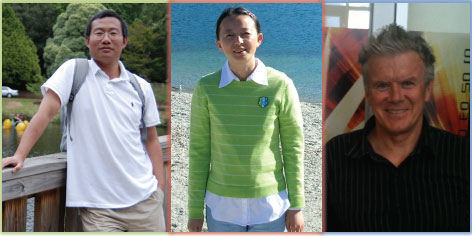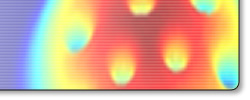In the quantum world of ultra-cold atoms, it is a grand challenge to understand the strongly interacting Fermi gas. This is a new paradigm in physics - a gas of particles that interact so incredibly strongly that quantum mechanics saturates their interactions. Like world-class boxers in the last round, these atoms simply can't take any more punishment. Not surprisingly, to predict how such powerful interactions will take place, and what type of matter is found, has fascinated physicists around the world, including ACQAO Centre of Excellence theorists(1,2).
Ultra-cold atom experiments(3,4) at the laboratories of the prestigious French university, Ecole Normale in Paris, have given a stunning verification of recent theoretical work at ACQAO. The Australian calculations of the interaction energy found at both very low and slightly higher temperatures were recently tested in the lab. Both came through with flying colours. With amazing accuracy, these new, highly quantitative experiments agree with earlier predictions to the last measured decimal place.
At Ecole Normale, atoms in the laboratory were cooled to a few billionths of a degree above absolute zero, then subjected to a magnetic field that enormously enhances the atom-atom coupling. In this domain, they mimic the strongly interacting particles found in neutron stars, or at the birth of the universe. Understanding strongly interacting quantum particles at these temperatures is not possible using conventional approaches. ACQAO COE theorists, Hu, Liu and Drummond developed new methods for their two milestone predictions, in 2006 and in 2009, of the state of this weird `unitarity' matter.
 ACQAO theorists (left to right): Hui Hu, Xia-Ji Liu and Peter Drummond
ACQAO theorists (left to right): Hui Hu, Xia-Ji Liu and Peter Drummond
Competing with these mathematical models are several computational approaches using supercomputers, in the USA and Switzerland. The experimentalists report that ACQAO theoretical predictions - using novel mathematical ideas - were correct.
The supercomputers were not as accurate. They have to buy the beer.
(1) Hui. Hu, Xia-Ji Liu, Peter D. Drummond, Equation of State of a superfluid Fermi gas in the BCS-BEC crossover, Europhys. Lett. 74, 574(2006).
(2) Xia-Ji Liu, Hui Hu, and Peter D. Drummond, Virial expansion for a strongly correlated Fermi gas, Phys. Rev. Lett. 102, 160401 (2009)
(3) S. Nascimbene, N. Navon, K. J. Jiang, F. Chevy and C. Salomon, Exploring the thermodynamics of a universal Fermi gas, Nature 463, 1057 (2010).
(4 ) N. Navon, S. Nascimbène, F. Chevy, and C. Salomon, The Equation of State of a Low-Temperature Fermi Gas with Tunable Interactions, Science, 328, 729 (2010).

